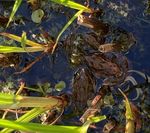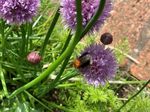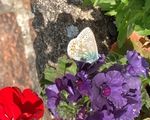WAYS TO MAKE YOUR GARDEN WILDLIFE FRIENDLY
←
→
Page content transcription
If your browser does not render page correctly, please read the page content below
WAYS TO MAKE YOUR GARDEN WILDLIFE FRIENDLY
A handy guide on ways to make your garden wildlife friendly and turn it into an
organic fine dining restaurant for a whole range of visitors, written by wildlife gardener
Jane Krish.
RELAX! It’s best not to be too tidy, but don’t just let it go: manage your
garden to suit the wildlife and soil in your neighbourhood.
BE PATIENT! Change happens slowly in nature.
NUMBER 1 PRIORITY - STOP USING ALL CHEMICALS such as
slug pellets, lawn feed, rose spray, fertiliser - and that includes organic
ones. If you have been using these, it may take a year or two for your
garden to settle down, but you’ll be saving money and helping bugs,
insects, birds and even hedgehogs to thrive and enjoy the new restaurant
you’re opening for them.
Jane’s wildlife garden
STOP WORRYING ABOUT SLUGS AND SNAILS - untainted by
chemicals, small mammals, birds, frogs, toads and snail hunting beetles can enjoy them safely. To be
sure of success aim to grow plants that they don’t want to eat. In my garden, I find they tend to leave
alone hellebores, iris, hardy geraniums, rambling roses, honeysuckles (grown for the moths), clematis,
alliums, lavender, rosemary, comfrey and lots more, including wild flowers like garlic mustard which
provides food for orange-tip butterfly caterpillars.
And, DON’T WORRY ABOUT THE APHIDS on your roses, leave them for the birds to enjoy – blue
tits and great tits love them, not to mention hoverflies, lacewings and ladybirds.
It’s great to PROVIDE A VARIETY OF FOOD for as much of the year
as possible for both birds and pollinators. [Pollinators include bees,
hoverflies, moths, butterflies and beetles.] Grow shrubs such as
cotoneaster, brilliant for attracting bumblebees, honey and solitary bees,
from late spring into summer, with lovely red berries for birds in winter.
Grow early-flowering plants like low growing comfrey, pulmonaria
(lungwort), mahonia (juicy berries after flowering), hellebore and Clematis
armandii. Leave seed heads standing in autumn. Ivy not only flowers late,
which is great for pollinators, it also offers a safe haven for insects,
amphibians and small birds during the cold weather and has berries
around the turn of the year. Our back fence is a fantastic green screen of
Bumblebee on a chive flower ivy.Hardy geraniums are a brilliant range of plants with great variety of flower shapes to suit different
pollinators which come out at different times over the summer. They also provide fantastic ground
cover for frogs, newts, small mammals, bugs and insects. Plus they keep the weeds down. As a result, I
only rarely need to do weeding. If the hardy geraniums get too large you can split them up and pot
them up for friends. When they finish flowering, chop them right down to the ground and their pretty
foliage will return quite quickly so they can continue to be great ground cover. Some might even flower
again.
MINI HOMES IN HABITAT PILES - Why not recycle garden waste into
mini habitat piles? For instance, tuck logs, pruned material from shrubs,
dead leaves and so on under shrubs, against a wall or into an undisturbed
corner and create a secret habitat for fungi, bugs and insects which
become food for birds, frogs, toads and newts. These damp places can also
provide hibernation homes for frogs, toads and newts.
YOUR GRASS – Even if you have a young family who need space to play,
consider allowing some of it to provide a variety of habitats. Mine is now
partly meadow with a mixture of cut grass, long grass and perennial wild
Habitat pile flowers, including cowslip, violet, primrose, self-heal, white and red clover,
bird’s-foot trefoil, ox-eye daisy, yellow (or hay) rattle and plantain which
grow back every year. If you live in the Bristol area you can buy plug plants from Avon Wildlife Trust’s
Grow Wilder https://www.avonwildlifetrust.org.uk/explore/grow-wilder
or buy seed from
https://www.organiccatalogue.com/seeds/featured-flower-seeds/wild-flower-seeds/
PROVIDING WATER
A pond is a marvellous way of increasing the number of species in your
garden. Our pond provides endless fascination with its frogs, newts,
damselflies and all sorts of mini species which simply arrived with no
introductions. The plants also provide variety. We've had it for 25 years
and it's taken time to evolve - every year is different in part because of
the weather.
We also have a very small pond, a recycled baby bath with pond liner,
which different generations of frogs enjoy over the summer. If you
install one of these then make sure you create a way out for them such
as some stones up to the rim.
Common frogs enjoying the pond
Bird bath: Blackbirds, sparrows and other small birds love to bathe
here and it provides water for other visitors too such as fox, hedgehog and our cat!
Water butts: These are a great way to save rainwater for periods of drought, which are becoming more
frequent with climate change. If you have a pond, aim to top it up with rainwater, not tapwater.BIRD FOOD – attract birds to your garden with bird food and once they're used to visiting, they'll
hunt out other juicy delights you have on offer in the way of chemical free berries, seeds, bugs, worms
and insects.
FEED THE SOIL – if you have space and don’t already have a
compost bin, it’s really worth it. We have two compost daleks which
sit directly on the soil, as you need worms to break it all down. I fill
one up with vegetable peelings, grass, weeds (but not bindweed or
ground elder), and 'brown' contents such as egg boxes, loo roll,
shredded paper - in detail here:
https://www.gardenorganic.org.uk/how-do-i-make-my-compost
When it’s full I let it be, usually for about a year, and start filling the
Compost daleks and habitat pile
other one. You'll know it's ready when the contents are all crumbly
and odourless and you can spread it around in early spring as food for
your soil and plants. If you need to buy compost, go for organic and peat free. Don't put any kind of
compost on your grass if you're growing wildflowers in it as they only thrive on poor soil.
YOU HAVE A VERY SMALL OUTSIDE SPACE
Why not try growing wildflowers in pots to suit your space and wait for the
pollinators to find them?
Useful website: https://www.gardenorganic.org.uk
TO FIND OUT MORE watch Jane’s film ‘Welcoming Wildlife to
Suburban Gardens’, which will be aired on Saturday 5th June 1pm, as part
of the Festival of Nature 2021 programme: www.festivalofnature.org.uk
Common blue butterfly
©Jane Krish 2021You can also read























































